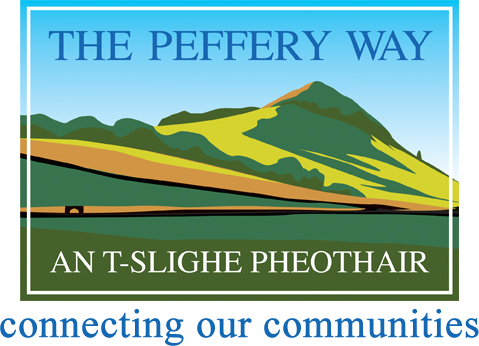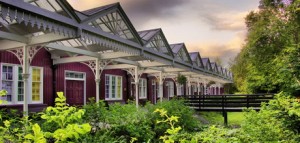
Strathpeffer station
The landscape of The Peffery Way/ An t-Slìghe Pheothair allows walkers and cyclists the opportunity to immerse themselves in history that can be traced back over 5000 years. From Dingwall to Strathpeffer the course of human habitation in the ‘Strath’ runs from the Bronze Age through to Victorian times and is still vibrant in the 21st century.
The river Peffery which lends its name to The Peffery Way comes from the Pictish word ‘pevr’ meaning shining or radiant. The village name of Strathpeffer refers to a wide, broad valley (srath = valley in Gaelic) that houses the Peffery river and therefore translates as ‘radiant valley’. When visiting on a sunny day the Peffery Way easily lives up to this title.
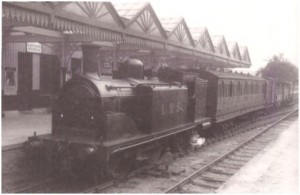
Strathpeffer railway station in her heyday
The path runs along the old Strathpeffer railway which opened in 1885 to serve the spa visitors of Strathpeffer. Visitors would arrive, often on an overnight service from London, to take the waters and avail themselves of numerous therapies offered at the grand Victorian hotels dotted around the village. Sadly, due to the impact of the First World War and declining tourist numbers, the line was closed in 1946. The Peffery Way begins (or ends) at the original railway station which houses a café and The Highland Museum of Childhood.
Leaving Strathpeffer on the path towards Dingwall you may notice on the left across the road the entrance to Castle Leod, the 15th century home to Clan Mackenzie. It is said that more recently Castle Leod served as inspiration for Diana Gabaldon’s Outlander series. The large area beside this encompasses the shinty pitch where the local team Caberfeidh play and also the cricket ground.
Located on a burn leading to the River Peffery (and abutting the road) is Milnain Mill. This watermill is from the Post Mediaeval period and was used for grinding corn and barley. The mill is now a private home though the water wheel remains intact.
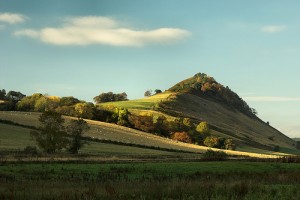
Knockfarrel
As the path heads towards Dingwall it is hard to ignore the large presence of Knockfarrel on the right hand side. This hill is known to have housed a large vitrified (burnt) Iron Age Fort and the view from the top is worth the walk up. To access Knockfarrel from the path visitors may stop at the old railway bridge and walk up the ‘zig zag’ path to begin the upward climb. The ‘zig zag’ path is reputed to be a ‘corpse road’ which was used by remote communities to access the cemetery in Fodderty for burials. When walking the ‘zig zag’ path be sure to look out for St. John the Baptist’s well on the left. Until recently the well was used as a clootie well where the ill would dip a cloth (cloot) into the water and hang it on a nearby tree or bush to hope for healing.
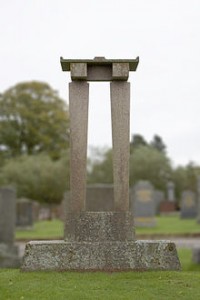
Willie Logan’s grave
When leaving the path at the railway bridge visitors can choose to turn left instead and visit Fodderty cemetery which holds the remains of William Logan, founder of Loganair and flamboyant contractor of the Tay Road Bridge. Logan’s grave memorial is in the shape of a piece of the Tay Bridge and the inscription reads: “Man of vision, courage and integrity. A pioneer of hydro-electric construction and a wise master-builder who contributed much to his native land. He left monuments to his skill in many parts.”
Returning to the path and heading towards Dingwall visitors will notice a crumbling building at the junction of the Dingwall to Skye line (on the left) which was used as the Signalman’s house. Users should continue along until, finally, the path begins to enter Dingwall, ancient Viking town and home to Ross County F.C. aka The Staggies. There are numerous tourist opportunities here ranging from the Sir Hector McDonald Monument to the final stretch of the River Peffery as it meets the Cromarty Firth via a Thomas Telford designed canal.
From start to finish the Peffery Way allows visitors to walk and cycle through 5000 years of history, from the Bronze Age to the 21st century and enjoy everything this radiant valley has to offer.
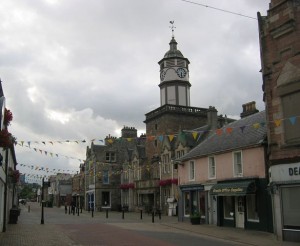
Dingwall High Street
